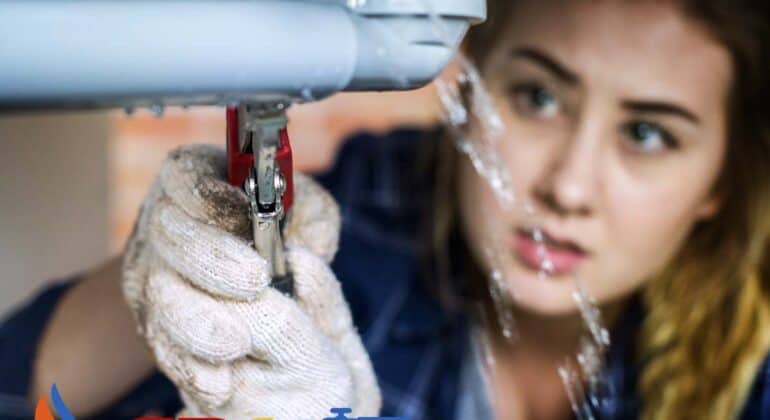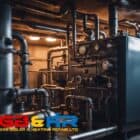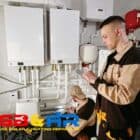Understanding how to manage the water supply in your home is crucial, not only for routine maintenance but also for sudden and unexpected situations. Should an emergency arise, such as a plumbing leak or a burst pipe, knowing how to promptly shut off the water can prevent extensive damage and save on costly repairs.
Knowing the location and operation of the valves in your home is essential because it can save your precious time and reduce stress when you need to cut the water.
The following guide will familiarise you with some tips to work the hot water supply in your home. This allows you to make routine checks and stop the water when you are faced with a leaking pipe when your pipes freeze or any other problem.
If you have any plumbing, boiler or central heating issues feel free to call us 24/7 – 07795034003.
Essential Items for Disabling Water Flow
Individual Fixture Valves
Your home’s fixtures such as toilets, sinks, and appliances possess dedicated valves. Finding these allows you to control the water flow to specific areas without affecting the entire household supply.
Main Home Valve
In urgent situations, like a burst pipe, you need immediate action. Utilise the main valve to halt the water supply to the entire house. It is typically situated on an exterior wall or within utility spaces.
Supply Meter Valve
Should an emergency occur involving internal plumbing, the supply meter valve is another point of interaction. Situated in an access box or within a property’s basement, this valve is crucial for controlling water during specific maintenance or incidents. Handle it with care to prevent damage.
How to Deactivate Water Supply at Kerbside
If a pipe bursts, swiftly turning off the water supply at the kerbside can prevent extensive harm to your residence and the environment. Here is how you do this:
- Locate the main water cover near the boundary of your property. This is typically marked with either ‘WM’ or ‘W’;
- Use a screwdriver to carefully lift the plastic or metal cover;
- Once open, remove the frost pad to uncover the stop tap;
- Rotate this tap in a clockwise direction to halt the water supply to your home. To resume the supply, simply turn it anticlockwise.
Before performing any plumbing maintenance, ensure the main water supply is switched off. Then, run your taps until any remaining water in the pipelines is depleted.
The kerbside shut-off valve should primarily be accessed under the following conditions:
- If a plumbing crisis occurs and the internal shut-off valve malfunctions;
- When a leak is detected in the pipeline connecting your home’s shut-off valve to the kerbside;
- When you need to replace or repair the main shut-off valve within your property boundaries.
If you have a plumbing problem, don’t hesitate to call our emergency plumbers in London – we are available 24/7 for plumbing as well as boiler repairs.
How to Deactivate Your Water Supply
Identifying the location of your water meter is crucial in the event of a plumbing issue. Typically, it is situated beneath the kitchen sink where the main water line enters your residence. In some homes, particularly those with a garden, it might be housed in an underground box. If you live in a more contemporary housing, the meter might be affixed to the external wall. For apartment dwellers, you can find it outside individual flats or within a communal metering area.
Having pinpointed your meter, gather the necessary instruments: a screwdriver, a curb stop key or a similar tool, and potentially a crescent wrench. With them, perform the following to suspend your water supply:
- Use the screwdriver to pry open the lid of the meter box.
- Locate the main shut-off valve, often an oblong knob with two side-by-side loops and a central arrow illustrating the flow direction, positioned on the side of the meter closer to the street.
- Put the wrench atop the centre point to initiate the supply shutdown.
- Carefully rotate the device clockwise, bringing the loops into alignment, which usually requires a 180-degree turn.
If the knob is stiff or immobile, resist the urge to exert excessive force as it could cause damage. Instead, a moderate, firm pressure should suffice. If the knob refuses to budge, it is recommended to seek assistance from your local water utility service.
How to Deactivate Your Household Water Supply
When faced with a crisis such as a burst pipe due to freezing temperatures, halting the water flow swiftly is crucial to averting further damage. Here’s how you can manage the main water shutoff valve effectively:
- Locate the Valve: Typically situated in the basement along an exterior-facing wall, within the garage, or adjacent to the boiler. Be careful not to mistake it for boiler-specific valves.
- Turning Off the Valve:
- If the valve has a lever, rotate it clockwise until it’s at a 90-degree angle to the pipe.
- For spherical or round handles, keep turning clockwise until it stops completely.
- Pressure Relief: To ensure there’s no residual pressure in the pipes that might lead to damage, turn on a faucet at the lowest level of your property.
If the primary shutoff proves elusive, look for the water meter valve. It will be within a box buried close to the street.
- Closing the Meter Valve:
- In case it’s not budging by hand, an adjustable wrench might be necessary.
- For a lever-style valve, adjust it clockwise until it forms a right angle with the pipe conduit.
- If the handle is round, similarly adjust it clockwise until you can tighten it no further.
How to turn off water supply to boiler?
Whether you have a new boiler or an old system, it is important to know how to deactivate the direct feed of water. The way you turn off the cold and hot water supply depends on the type of boiler and heating system you have.
Worcester Boiler Water Supply Shutdown
To stop the water to your Worcester boiler, locate the main stop valve supplying the unit. You’ll usually find this attached to the boiler or on the pipe work nearby. Turn it until it is crosswise to the pipe to stop water flow.
Combi Boiler Hot Water Deactivation
Combi boilers make stopping hot water straightforward. Find the main stopcock, often situated under the kitchen sink or near the meter. Rotate it to cut off the water supply to the combi boiler.
Baxi Boiler Water Supply Disengagement
To turn off your Baxi boiler’s water supply, search for the main water shut-off control. This valve is commonly positioned on the pipes close to the boiler. Rotate it to a perpendicular angle to the pipe to cut water entry.
System Boiler Water Supply Cut-off
Shutting off water to a system boiler necessitates locating the principal valve linked to the boiler setup. Twist it to a right angle against the pipe’s direction to halt the water supply.
Hot water cylinder deactivation
A hot water cylinder uses an indirect supply from a cold water storage cistern, which demands a different approach. It draws hot water from the top and it pressurises cold water to the bottom. You need to find the valve on the pipe that enters the hot water cylinder from the water storage cistern. That is the valve you need to locate to turn off the water.
Alpha C23 Boiler Hot Water Deactivation
If you need to stop the hot water on an Alpha C23 boiler, look for the boiler’s primary water shut-off valve. It’s usually attached directly to the boiler or nearby pipes. Turn it to a 90-degree angle against the pipe to cease water flow.
A heat only boiler deactivation
Conventional boilers are similar to system boilers, but there is one major difference. The cylinder is not under mains water pressure. Instead, water pressure comes from gravity. This is why a cold water supply tank is usually employed in the system and that tank is located in the loft or another high point of the home. Look for a valve to cut the water near the main storage cylinder.
How to Isolate the Water Supply to Other Sources
Turning off Water to Bathroom Taps
To prevent water damage during repairs, you should know how to isolate the taps. Underneath the sink, you’ll find individual shutoff valves – one for the hot water (on the left) and one for the cold water (on the right). By turning these valves until they can no longer move, you can effectively stop the water flow. Remember to rotate the valves slowly and gently to not damage them. Open the taps so that any remaining water in the pipes is depleted.
Turning off Water Flow to the toilet
There is usually a single valve controlling water to the toilet. It is usually located near the toilet base. You should cut that water supply if you need to do any repairs on the toilet. Try reaching for the valve with slip-joint pliers or a wrench. Once you have shut the valve, flush the toilet to ensure no water is reaching the water pipe.
Turning off Water Flow to Radiators
If maintenance calls for shutting off a radiator’s water supply, both the thermostatic valve (usually found on the left side at the bottom) and the lockshield valve (on the right side) need to be closed by turning them clockwise. The thermostatic valve will have numbers or settings that will reach zero, while the lockshield valve should be closed completely. This prevents water from entering the radiator, allowing it to cool down as you do the necessary maintenance and repair work.
Turning off Water to the Central Heating System
For draining or stopping the water from refilling your central heating system, you must understand the system type. With a vented system, you can approach this by either tying up the float valve in the feed and expansion cistern or closing the valve on the cistern’s incoming pipe. Sealed systems don’t require action unless refilled.
Should you need your central heating repaired or serviced, you can call our Gas Safe Registered engineers anytime as we’re available for emergencies as well.
Sealing Off the Water Supply to the Kitchen Sink
When it’s time to work on the kitchen sink, the cold and hot water lines each have their respective shut-off valves, typically inside the cabinet where the pipes enter the wall. By turning the levers or knobs to the off position (perpendicular to the pipe for levers), you cut the water supply. After ensuring these valves are closed, open the taps to release the water pressure in the pipes as well as the remaining water.
If these valves aren’t accessible or the issue goes beyond the sink, you may need to use the main shut-off valve for the house. It’s crucial to turn off the water mains, found at the junction of the household system and the city line or near the meter.
In conclusion
Knowing how to turn off the water supply to your home is essential for minimising water damage in case of an emergency, issues from extreme cold weather and more. You should know the position of your main shutoff valve and how to quickly stop the water so that you can prevent further damage and do maintenance and repair work on the pipes.
If you have any sort of problem that you are not able to address, make sure you contact our experts at Gas Boiler & Heating Repair LTD. We are available 24/7 to inspect and fix any problem with your boiler and heating system. Do not hesitate to contact our service today.
Frequently asked questions
What should you do if the stopcock valve is not working?
If the part is stuck and doesn’t move, try turning it in both directions. Spray some oil down the shaft and near the gland nut to make it easier to move. If that doesn’t help either, you may need to remove the gland nut.
Is it safe for your boiler to shut off the water supply at the stopcock?
The heat exchanger in a combi boiler may suffer if you turn off the water but leave the boiler on. Your radiators and cylinder boiler will be fine though. Make sure you know of the risks for the heat exchanger of a combi boiler.
Can you use a boiler if the water is turned off?
A combi boiler will still provide heating but without access to the main supply of water, there will only be cold water. For a conventional boiler and heat-only boiler, it will still heat the radiators even with the water turned off.
How does turning off water at the mains affect combi boilers?
This is a very small risk to combi boilers. Normally, they will shut down automatically as they detect a drop in mains pressure or too high a temperature. If there is not enough cold water passing, the boiler shuts down.



